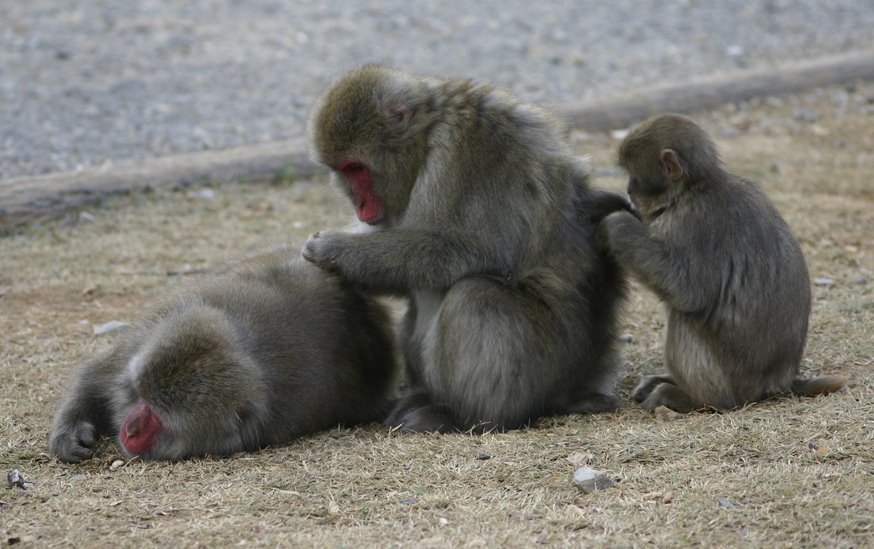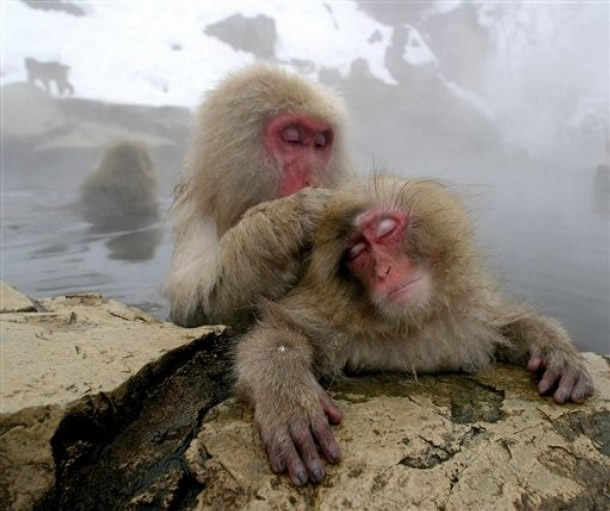Social Grooming In Primates
Biology 342 Fall 08
David Krueger and Lanlan Jin
Adaptive Value

Figure 8: Allogrooming Monkeys (/www.phpsolvent.com)
Social Grooming in primates serves two primary adaptive functions: hygiene and social bonding.
Hygeinic Benefits of Grooming
While bonding is the main function in primates, studies have shown that animals are allogroomed more in areas which they have a harder time reaching and hence the behavior does serve a hygienic purpose. Grooming removes dirt, insects, parasites, dead skin, tangled fur, &c., and generally help to keep an animal's skin and hair in good condition. Thus being groomed benefits an animal's physical condition and health, making well groomed animals more fit as a result. The adaptive value of being groomed should be clear, then, but why would an animal have the incentive to groom another? This idea can be explained by the reciprocity hypothesis (Thierry, 1990; Muroyama,1991; Silk , 2005; Ventura et al., 2006; Schino, 2007).
Reciprocity
Reciprocity is a way of explaining the evolution of seemingly altruistic or cooperative behaviors in animals. The idea is an "altruistic" action done by one creature to benefit another will prompt either a beneficial response from the receiving animal (direct reciprocity) or will increase their expected reception of beneficial actions from other animals in general because of the behavior, usually on the basis of reputation (indirect reciprocity).(Muroyama, 1991)
Reciprocity and Allogrooming
It is common for grooming to be reciprocated immediately, the groomee becoming the groomer. This is direct reciprocation. So one reason allogrooming is adaptive for the groomer is because they receive the hygienic benefits of being groomed themselves.
There may also be other forms of direct reciprocation, such as immediate reduction of aggression, sharing of resources, or assistance in a conflict. Social bonding between grooming individuals may also be a form of direct reciprocity. While the benefits of the bond may not seem "direct," the bonding is a "response" from the receiving animal(Ventura et al.,2006). It has been observed within primate groups that individuals generally must give allogrooming in order to receive it and that there is, in fact, a significant correlation between the amount of grooming given and received by an individual. This is because of the frequency of direct reciprocation in the from of grooming .
Primates may also make different types of vocalization to indicate whether they want to groom or be groomed, so individuals can communicate their desires and assess others' intentions. A study on female Japanese Macaques (Macaca Fuscata) indicates that grooming individuals may use soliciting postures (after a certain time has passed) to signal the recipient that it's time for the groomer to be groomed. These communications allow for effective regulation of reciprocity (Muroyama, 1991).

Figure 9: Japanese macaques grooming each other in hot springs. (www.daylife.com)
Rank and Reciprocity
Reciprocity may function somewhat differently in allogrooming occurring between lower ranked and higher ranked individuals. There is evidence that a lower ranked individual is more likely to groom a higher ranked individual than an individual with the same or lower rank. When a lower-ranked individual grooms a higher-ranked individual, it generally receives protection and greater acceptance and standing in society in return, rather than, or in addition to reciprocation of grooming. Any of these responses are beneficial, however, and will increase the groomer's fitness (Thierry, 1990).
Indirect reciprocity may also come into play for this behavior in primate populations. In situations of low-ranked individuals grooming high-ranked individuals, the betterment in social status of the groomer may be a direct result of actions of the recipient, or it may simply result from other animals observing the encounter, making it indirect reciprocity; it's probably a combination of the two (Ventura et al., 2006).
Bonding as Distinct from Reciprocity
There may also be adaptive value to the behavior not involving reciprocity. The process of grooming and reciprocation fosters bonding between the individuals involved, regardless of whether the groomer benefits from a clear reciprocal response. Because allogrooming benefits each individual and engenders bonding between the individuals, it serves to facilitate and mediate social interactions within primate groups, which allows for successful group living, which entails large fitness benefits for group members.
"True Altruism" and Grooming in Kin Groups
As an additional or alternate explanation, it has also been hypothesized that at least some grooming is "truly altruistic" in that it does not confer a greater expected benefit than cost on the groomer. According to this hypothesis, grooming behavior is selected for via kinship selection. This would mean that while allogrooming may not confer a fitness advantage to an individual, it would confer a fitness advantage to their family (Schino, 2007). Since family members are more closely related, they share more genes with each other and hence by increasing each others' fitness, they increase the expected fitness of parts, at least, of their genome. Closer relatives do indeed spend more time grooming each other (especially in the case between mothers and infants), so this hypothesis is supported somewhat by experimental evidence.